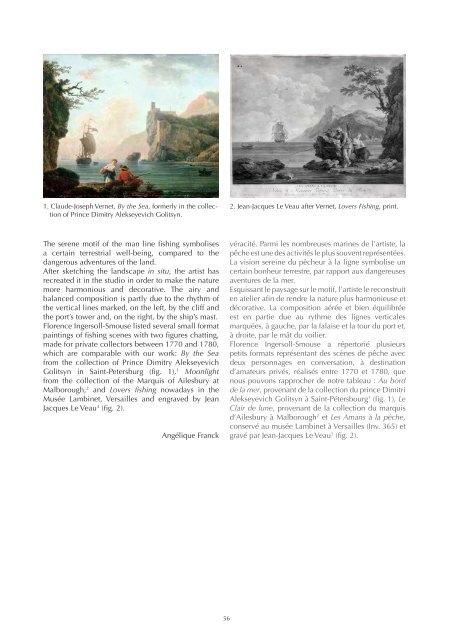XVII - Master Paintings - Jean Luc Baroni and Marty de Cambiaire
Create successful ePaper yourself
Turn your PDF publications into a flip-book with our unique Google optimized e-Paper software.
1. Clau<strong>de</strong>-Joseph Vernet, By the Sea, formerly in the collection<br />
of Prince Dimitry Alekseyevich Golitsyn.<br />
2. <strong>Jean</strong>-Jacques Le Veau after Vernet, Lovers Fishing, print.<br />
The serene motif of the man line fishing symbolises<br />
a certain terrestrial well-being, compared to the<br />
dangerous adventures of the l<strong>and</strong>.<br />
After sketching the l<strong>and</strong>scape in situ, the artist has<br />
recreated it in the studio in or<strong>de</strong>r to make the nature<br />
more harmonious <strong>and</strong> <strong>de</strong>corative. The airy <strong>and</strong><br />
balanced composition is partly due to the rhythm of<br />
the vertical lines marked, on the left, by the cliff <strong>and</strong><br />
the port’s tower <strong>and</strong>, on the right, by the ship’s mast.<br />
Florence Ingersoll-Smouse listed several small format<br />
paintings of fishing scenes with two figures chatting,<br />
ma<strong>de</strong> for private collectors between 1770 <strong>and</strong> 1780,<br />
which are comparable with our work: By the Sea<br />
from the collection of Prince Dimitry Alekseyevich<br />
Golitsyn in Saint-Petersburg (fig. 1), 1 Moonlight<br />
from the collection of the Marquis of Ailesbury at<br />
Malborough, 2 <strong>and</strong> Lovers fishing nowadays in the<br />
Musée Lambinet, Versailles <strong>and</strong> engraved by <strong>Jean</strong><br />
Jacques Le Veau 3 (fig. 2).<br />
Angélique Franck<br />
véracité. Parmi les nombreuses marines <strong>de</strong> l’artiste, la<br />
pêche est une <strong>de</strong>s activités le plus souvent représentées.<br />
La vision sereine du pêcheur à la ligne symbolise un<br />
certain bonheur terrestre, par rapport aux dangereuses<br />
aventures <strong>de</strong> la mer.<br />
Esquissant le paysage sur le motif, l’artiste le reconstruit<br />
en atelier afin <strong>de</strong> rendre la nature plus harmonieuse et<br />
décorative. La composition aérée et bien équilibrée<br />
est en partie due au rythme <strong>de</strong>s lignes verticales<br />
marquées, à gauche, par la falaise et la tour du port et,<br />
à droite, par le mât du voilier.<br />
Florence Ingersoll-Smouse a répertorié plusieurs<br />
petits formats représentant <strong>de</strong>s scènes <strong>de</strong> pêche avec<br />
<strong>de</strong>ux personnages en conversation, à <strong>de</strong>stination<br />
d’amateurs privés, réalisés entre 1770 et 1780, que<br />
nous pouvons rapprocher <strong>de</strong> notre tableau : Au bord<br />
<strong>de</strong> la mer, provenant <strong>de</strong> la collection du prince Dimitri<br />
Alekseyevich Golitsyn à Saint-Pétersbourg 1 (fig. 1), Le<br />
Clair <strong>de</strong> lune, provenant <strong>de</strong> la collection du marquis<br />
d’Ailesbury à Malborough 2 et Les Amans à la pêche,<br />
conservé au musée Lambinet à Versailles (Inv. 365) et<br />
gravé par <strong>Jean</strong>-Jacques Le Veau 3 (fig. 2).<br />
56















